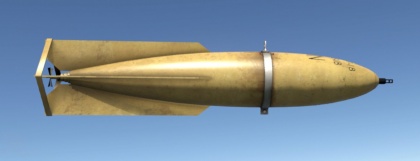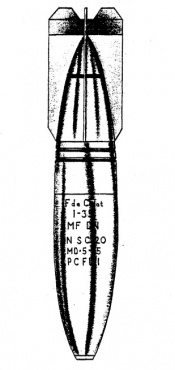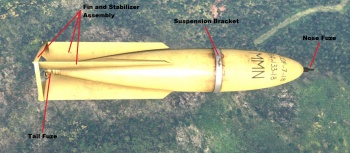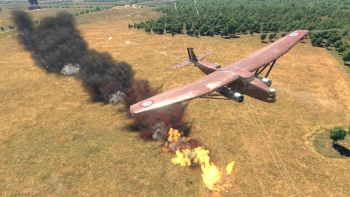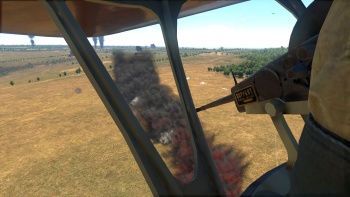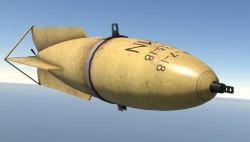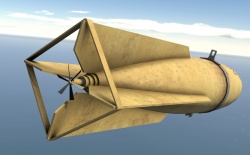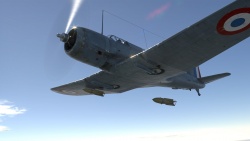G.A. MMN. 50 (50 kg)
Contents
Description
The G.A. MMN. 50 (50 kg) is a 50 kg bomb which was constructed out of welded rolled sheet steel; it has either a longitudinal or a circumferential weld[1]. The overall colour of the bomb is yellow and typically had the type of explosive filling and words "F de Culot" (F of Base or Fuse in Base) painted on the bomb casing.
| Data for G.A. MMN. 50 (50 kg) bomb | |||
|---|---|---|---|
| In-game | Historical[2] | ||
| Overall Length | -- | 118 cm | 46.5 in |
| Body Diameter | -- | 19.9 cm | 7.85 in |
| Fuse Type | -- | M. No.2 | Tail mount |
| Filling | TnT | (Fr) M.Mn | (USA) Trimonite |
| Filling Weight | 28.5 kg | 28.6 kg | 63 lb |
| Total Weight | 50 kg | 50 kg | 112 lb |
Vehicles which can equip the G.A. MMN. 50 (50 kg)
| Aircraft which can carry G.A. MMN. 50 (50 kg) | Total Number | Total weight kg | Total weight lb |
|---|---|---|---|
| F.222.2 | 52 | 2,600 kg | 5,732 lb |
| N.C.223.3 | 52 | 2,600 kg | 5,732 lb |
| V-156-F | 2 | 100 kg | 220.5 lb |
| Potez 633 | 8 | 400 kg | 882 lb |
| M.B.174A-3 | 8 | 400 kg | 882 lb |
| LeO 451 /early | 16 | 800 kg | 1,764 lb |
| LeO 451 /late | 16 | 800 kg | 1,764 lb |
General info
Effective damage
The G.A. MMN. 50 (50 kg) is filled with Mélinite-Mononitro-nitronaphtaline (M.Mn)[3] or Trimonite (70% Melinite - Picric Acid and 30% Mononitionapthalene). These are typically general purpose/anti-personnel bombs with a Picric acid burster[4] charge. In-game, the explosive has been simplified to Trinitrotoluene (TnT - C7H5N3O6) which is chemically very similar to Mélinite (C6H3N3O7) and Mononitro-nitroaphtaline (C10H7NO2).
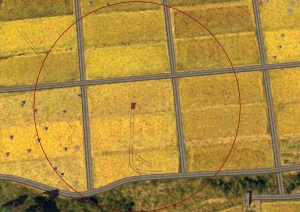
| G.A. MMN. 50 (50 kg) damage table | Metric | Imperial |
|---|---|---|
| Max armor penetration high explosive action | 82 mm | 3.2 in |
| Radius of destruction of armored vehicle | 2.4 m | 8 ft |
| Radius of fragment dispersion | 77.1 m | 253 ft |
Comparison with analogues
| Comparable bombs to G.A. MMN. 50 (50 kg) | |||||||
|---|---|---|---|---|---|---|---|
| Name | Mass | Explosive mass | Explosive | Armor Pen. | Destruction radius | Frag radius | |
| ▃ | AN-M30A1 | 100 lb | 24.5 kg | Amatol | 79 mm | 2.1 m | 67.3 m |
| ▂ | FAB-50 | 64 kg | 24 kg | TNT | 79 mm | 2.1 m | 68.6 m |
| ▀ | SC50JA | 50 kg | 25 kg | Fp.60/40 | 80 mm | 2.1 m | 70.1 m |
| ▅ | Type 97 Number 6 | 60 kg | 23 kg | TNT | 78 mm | 2.1 m | 67 m |
| ▅ | Type 94 GPHE | 50 kg | 19.6 kg | TNT | 74 mm | 1.8 m | 62.5 m |
| ▄ | GP 50 | 58 kg | 25 kg | TNT | 80 mm | 2.1 m | 70.1 m |
| ▄ | D.T. No.2 | 55.7 kg | 19.9 kg | TNT | 73 mm | 2.1 m | 67.4 m |
Usage in the battles
Due to the small size of the G.A. MMN. 50 (50 kg), it is not advisable to drop just one at a time. Many of the French bombers can carry between 2 and 52 of these bombs and can cause more damage when dropped en masse over an area also known as "carpet bombing." The lower altitude you drop the bombs from, the less time enemy vehicles (including AI drivers) have to avoid the in-bound bombs. These bombs are effective against:
- AA vehicles
- AAA cannons (non pill-box)
- Enemy aircraft landing or parked on a runway
- Clustered or columns of vehicles
Pros and cons
Pros:
- Effectively used for carpet bombing lightly or no armoured targets
- Large payload aircraft like F.222.2 and N.C.223.3 can take out columns of AA vehicles in one pass
Cons:
- Less effective against armoured vehicles, reinforced pillboxes and bases
- Hard to concentrate large amounts of damage with small bombs
History
Examine the history of the creation and combat usage of this weapon. If the historical reference turns out to be a big one, take it into a separate article and add a link to it by using the "main" template. In the end, be sure to include references to sources.
Media
An excellent addition to the article would be a video guide, as well as screenshots from the game and photos.
-
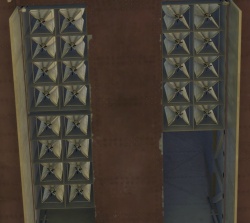 G.A. MMN. 50 (50 kg) bombs in the bomb bay of an F.222.2, notice how they are stored upright when dropped
G.A. MMN. 50 (50 kg) bombs in the bomb bay of an F.222.2, notice how they are stored upright when dropped
Read also
Links to the articles on the War Thunder Wiki that you think will be useful for the reader, for example,
- reference to the article about the variant of the cannon/machine gun;
- references to approximate analogues by other nations and research trees.
ETC.
Sources
Paste links to sources and external resources, such as:
- topic on the official game forum
- page on the Wikipedia
- page on aircraft or ground forces encyclopedia
- other literature
- ↑ OP 1668 - U.S. Naval and Systems Ordnance Command - Italian and French Explosive Ordnance, June 1946, p. 184
- ↑ OP 1668 - U.S. Naval and Systems Ordnance Command - Italian and French Explosive Ordnance, June 1946, p. 184
- ↑ FTC 381-5042 Handbook of Foreign Explosives - U.S. Army Foreign Science and Technology Center, October 1965, p. 226
- ↑ FTC 381-5042 Handbook of Foreign Explosives - U.S. Army Foreign Science and Technology Center, October 1965, p. 120


